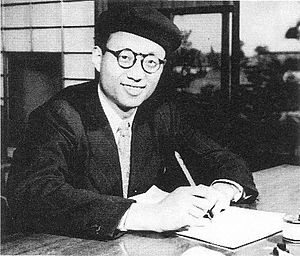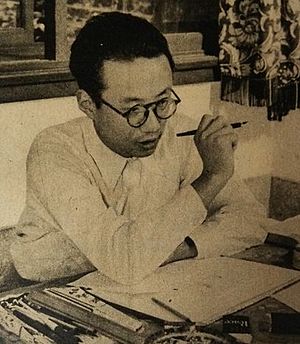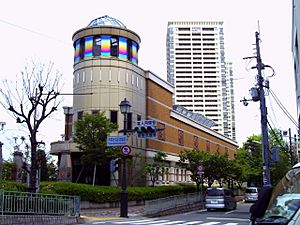Osamu Tezuka facts for kids
Quick facts for kids
Osamu Tezuka
|
|||||
|---|---|---|---|---|---|

Tezuka in 1951
|
|||||
| Born |
Tezuka Osamu (手塚 治)
3 November 1928 Toyonaka, Osaka Prefecture, Empire of Japan
|
||||
| Died | 9 February 1989 (aged 60) Tokyo, Japan
|
||||
| Education |
|
||||
| Occupation |
|
||||
| Years active | 1946–1989 | ||||
| Organization |
|
||||
|
Notable work
|
|
||||
| Spouse(s) |
Etsuko Okada
(m. 1959–1989) |
||||
| Children |
|
||||
| Japanese name | |||||
| Kanji | 手塚 治虫 | ||||
|
|||||
| Signature | |||||
 |
|||||
Osamu Tezuka (手塚 治虫, born 手塚 治, Tezuka Osamu; 3 November 1928 – 9 February 1989) was a famous Japanese manga artist, cartoonist, and animator. He was born in Osaka Prefecture. Tezuka created many works and used new techniques. This earned him titles like "the Father of Manga" and "the God of Manga". Many people also call him the Japanese Walt Disney, who was a big inspiration for Tezuka.
Tezuka started a "manga revolution" in Japan with his comic New Treasure Island in 1947. He created many popular and important manga series. These include children's comics like Astro Boy, Princess Knight, and Kimba the White Lion. He also made comics for older readers, such as Black Jack, Phoenix, and Buddha. Many of his works won awards.
Tezuka passed away from stomach cancer in 1989. His death had a big effect on people in Japan and other cartoonists. A museum was built in Takarazuka to honor his life and work. Tezuka also received many awards after his death. Some animations and the last parts of his Phoenix series were still being made when he died. These final parts were never released.
Contents
About Osamu Tezuka
His Early Life (1928–1945)
Tezuka was born in Toyonaka, Osaka. He was the oldest of three children. His family was successful and well-educated. His father worked in management, and his grandfathers were a lawyer and doctors.
Tezuka said his mother helped him feel confident and creative with her stories. She often took him to the Takarazuka Grand Theater. This theater featured the Takarazuka Revue, an all-female musical group. Their romantic musicals greatly influenced Tezuka's later works, including his costume designs. The performers' large, sparkling eyes also inspired his art style.
When Tezuka was young, his father showed him Walt Disney films. Tezuka loved Disney movies, watching Bambi more than 80 times! He started drawing comics around second grade, inspired by Disney. He drew so much that his mother had to erase pages in his notebooks. Tezuka was also inspired by works from Suihō Tagawa and Unno Juza. He later said that watching the Chinese animation Princess Iron Fan as a child was the most important reason he wanted to be an animator.
Around age five, he found a ground beetle, called "Osamushi" in Japanese. Since it sounded like his own name, he used "Osamushi" as his pen name. Tezuka kept improving his manga skills throughout school. During this time, he created his first good amateur works.
In 1944, during high school, Tezuka was asked to work in a factory to help Japan in World War II. He still kept writing manga at the same time. In 1945, Tezuka was accepted into Osaka University to study medicine. While studying, he also began publishing his first professional works.
First Big Success (1946–1951)
Tezuka realized he could use manga to help people care about the world. After World War II, at age 17, he published his first professional work, Diary of Ma-chan. It appeared in a children's newspaper in early 1946.
Tezuka then worked with fellow manga creator Shichima Sakai. Sakai suggested a story based on Treasure Island. Tezuka finished the manga, loosely based on the original book. Shin Takarajima (New Treasure Island) was published and became a huge hit overnight. This started the "golden age" of manga in Japan.
After New Treasure Island became popular, Tezuka went to Tokyo to find more publishers. While still in medical school, Tezuka published his first masterpieces. These were three science fiction stories: Lost World (1948), Metropolis (1949), and Nextworld (1951). These works included early steampunk ideas.
Soon after, Tezuka published another major success, Kimba the White Lion. This comic was printed in Manga Shonen from 1950 to 1954.
In 1951, Tezuka graduated from Osaka School of Medicine. He also published Ambassador Atom, which was the first time the Astro Boy character appeared. That same year, Tezuka joined a group called the Tokyo Children Manga Association.
The Rise of Astro Boy (1952–1960)
By 1952, Ambassador Atom was somewhat successful in Japan. However, one character, a robot named Atom, became very popular with young boys. Tezuka received many letters from children. He decided to create a series about Atom. On 4 February 1952, Tetsuwan Atom began in Weekly Shonen Magazine. The character Atom and his adventures quickly became a sensation in Japan.
Because Tetsuwan Atom was so successful, Tezuka published the shōjo manga Ribon no Kishi (Princess Knight) in 1953. It was printed in Shojo Club from 1953 to 1956.
In 1954, Tezuka first published what he considered his most important work, Phoenix. It first appeared in Mushi Production Commercial Firm.
Animation Career (1959–1989)
Tezuka's first work to be made into an animation was Saiyuki. This was a new version of the Chinese story Journey to the West. Toei Animation produced it, and Tezuka was officially the director. However, he often found it hard to stay motivated for the animation work. Most of the directing was done by Yabushita Taiji. Tezuka was given the job of drawing storyboards for the film. He finally delivered his 500-page storyboard in 1959.
Many animators were surprised by how much they had to draw in a short time. But Tezuka's simple art style made the animation process much faster.
Tezuka did not enjoy his time at Toei. He felt he had no control over his story or its ending. This film was a big moment in animation history. It showed how simplified art and limited animation could save time and money. It also introduced Tezuka to animators he would later hire for his own studio.
In 1961, Tezuka started his own animation company, Mushi Productions. He hired animators he had met at Toei by paying them more. Their first film was Tales from a Certain Street Corner. This was an experimental film. Tezuka often missed his own deadlines, and his staff had to work extra hard.
Astro Boy first aired on New Year's Day 1963. This series created the first successful way to produce animation in Japan. It was also the first Japanese animation to be dubbed into English for an American audience. It also created a market for children's toys and products. Tezuka was able to keep costs low by using techniques like "shooting on threes" (showing each drawing for three frames), using still images, and repeating scenes.
Selling Astro Boy to an American company, NBC Enterprises, was very important. This company ordered 52 episodes, which was a big help because Mushi Pro only had a few episodes ready. The American company had strict rules: no signs that the show was made in Japan, no story arcs lasting more than one episode, all street signs in English, and no religious references. Tezuka agreed to this. However, he was later disappointed when the Americans decided they had enough episodes and didn't need more.
Other series were also made into animation. This included Jungle Emperor (1965), which was the first Japanese animated series made in full color. Jungle Emperor was also sold to NBC Enterprises.
By the late 1960s and 1970s, Mushi Pro faced financial problems. Tezuka's way of managing money was not working, and the company was in debt.
Tezuka left his role as director in 1968 to start a new animation studio, Tezuka Productions. He kept trying new things with animation for the rest of his life. In 1973, Mushi Productions went bankrupt. From its downfall, several important animation studios were created, including Sunrise.
Gekiga Graphic Novels (1967–1989)
In 1967, Tezuka created the magazine COM. He changed his art style from a cartoony, Disney-like look to a more realistic drawing style. At this time, his books started focusing on adult themes. These stories often showed characters with dark and complex personalities. They also included clear violence and crime.
His manga began to change from children's stories to more "literary" gekiga manga with the yōkai manga Dororo in 1967. This was influenced by the success of Shigeru Mizuki's GeGeGe no Kitarō. He also produced Vampires, which, like Dororo, had a stronger, clearer story and a different drawing style. After these, he began his first true gekiga attempt with Swallowing the Earth.
Besides the well-known series Phoenix, Black Jack, and Buddha, he also made many one-shot or shorter series. These include Ayako, Ode to Kirihito, Alabaster, Apollo's Song, Barbara, MW, and The Book of Human Insects. He also made many short stories that were later collected in books.
Tezuka's stories became a bit softer in the 1980s with works like Message to Adolf, Midnight, Ludwig B (which was not finished), and Neo Faust.
His Passing
Tezuka died from stomach cancer on 9 February 1989 in Tokyo. His last words were: "I'm begging you, let me work!", spoken to a nurse who tried to take away his drawing tools.
In 2014, Tezuka's daughter, Rumiko Tezuka, opened a locked drawer in her father's desk. Inside, she found a half-eaten piece of chocolate, an essay about Katsuhiro Otomo's work on Akira, and sketches from his projects.
Tezuka's Unique Style
Tezuka is known for his creative stories and his Japanese versions of Western literature. His "cinematic" page layouts were inspired by Milt Gross's early graphic novel He Done Her Wrong. He read this book as a child, and its style influenced many manga artists after him. His work, like other manga creators, was sometimes serious and violent.
A key part of Tezuka’s style was using ideas from popular works and trends. For example, he used different levels of depth in one drawing, like the "deep-focus" camera technique in Hollywood films. His Metropolis manga shows this, along with "pans, close-ups, and zooms" that made his scenes feel like they were moving.
Tezuka also adapted his style to fit what his audience liked. He included "kiss scenes" because they were becoming popular in Japanese films. He mixed this with Japanese ideas, like "glorifying self-sacrifice." Instead of a usual happy ending, one or more characters might die to help others. A special part of Tezuka’s style was the Star System. This meant he used the same characters in different comics, but they played different roles. It was like how actors change their personality for different movies. This allowed Tezuka to create connections and references between his different works.
He created the unique "large eyes" style of Japanese animation. He got this idea from Western cartoons and animated films like Betty Boop, Mickey Mouse, and other Disney movies.
How His Style Changed
Tezuka's early professional work included four-panel comics like The Diary of Mā-chan. But it was the akahon format of New Treasure Island, a 200-page comic book, that made him famous. Akahon comics were known for their cheap paper and bright red covers, which made them easy to share. Tezuka made his akahon comics more complex and moral than usual. He also used English titles and detailed drawings, which were different from other akahon. Later, Tezuka had to change his style to fit serialized magazines. He created the "single charismatic hero," like Atom, to keep readers interested in his ongoing stories.
Famous Works
Tezuka created over 700 volumes of manga, with more than 150,000 pages. His creations include Astro Boy (called Mighty Atom in Japan), Black Jack, Princess Knight, Phoenix (Hi no Tori in Japan), Kimba the White Lion (Jungle Emperor in Japan), Unico, Message to Adolf, The Amazing 3, Buddha, and Dororo. His "life's work" was Phoenix—a story about life and death that he started in the 1950s and continued until he died.
Tezuka also led the animation studio Mushi Production. This studio was a pioneer in making TV animation in Japan.
His Personal Life
Tezuka was a descendant of Hattori Hanzō, a famous ninja and samurai from Japan's Sengoku period.
As a child, Tezuka's nickname was gashagasha-atama, meaning "messy head." When he was young, his arms swelled up and he became ill. A doctor treated and cured him, which made Tezuka want to be a doctor too. At one point, he asked his mother if he should become a full-time manga artist or a doctor. Being a manga artist was not a well-paying job back then. His mother told him: "You should work doing the thing you like most of all." Tezuka decided to focus on creating manga full-time. He did graduate from Osaka University and earned his medical degree. He later used his medical and scientific knowledge to make his sci-fi manga, like Black Jack, even better.
Tezuka loved insect collecting and entomology (the study of insects). He even added the Japanese character for "bug" (虫) to his pen name. He also loved Disney and baseball. He even licensed the "grown up" version of his character Kimba the White Lion as the logo for the Seibu Lions baseball team. Tezuka was a big fan of Superman and was the honorary chairman of Japan's Superman Fan Club.
In 1959, Osamu Tezuka married Etsuko Okada in a Takarazuka hotel.
Tezuka met Walt Disney in person at the 1964 New York World's Fair. In his diary, Tezuka wrote that Disney wanted to hire him for a science fiction project.
In January 1965, Tezuka received a letter from American film director Stanley Kubrick. Kubrick had seen Astro Boy and wanted Tezuka to be the art director for his next movie, 2001: A Space Odyssey. Tezuka was honored but could not leave his studio for a year to live in England. So, he had to turn down the offer. Even though he couldn't work on 2001, he loved the film. He would play its soundtrack loudly in his studio to stay awake during long nights of work.
Tezuka's son Makoto Tezuka also became a film and anime director.
His Legacy and Influence
Stamps were made in Tezuka's honor in 1997. Also, starting in 2003, the Japanese toy company Kaiyodo began making figurines of Tezuka's characters. These included Princess Knight, Unico, Phoenix, Dororo, and Astro Boy.
Tezuka's legacy continues to be honored by manga artists and animators. He guided many famous manga artists, such as Shotaro Ishinomori and Go Nagai. Artists like Monkey Punch, Katsuhiro Otomo, Akira Toriyama, and Naoki Urasawa have said Tezuka influenced them. From 2003 to 2009, Urasawa and Takashi Nagasaki adapted a part of Astro Boy into the mystery series Pluto.
Tezuka was a friend of Brazilian comic book artist Mauricio de Sousa. In 2012, Maurício published a comic story where some of Tezuka's main characters, like Astro Boy and Kimba, joined Monica and her friends in an adventure. This was the first time Tezuka Productions allowed artists from other countries to use Tezuka's characters.
In October 2019, a project called Tezuka 2020 was announced. This project uses AI to create manga in Tezuka's style. In 2020, an AI writer-artist made a new "Tezuka" manga called Paidon. It takes place in a future world after an apocalypse. This manga was released in a magazine and is part of the project. Tezuka's son held a ceremony to introduce the manga. The publisher has already confirmed that a sequel is being made.
Awards and Recognition
- 1957 Shogakukan Manga Award for Manga Seminar on Biology and Biiko-chan
- 1975 Bungeishunjū manga Award
- 1975 Japan Cartoonists Association Award—Special Award
- 1977 Kodansha Manga Award for Black Jack and The Three-Eyed One
- 1980 Inkpot Award, San Diego Comic-Con
- 1983 Shogakukan Manga Award for Hidamari no Ki
- 1984 Animafest Zagreb Grand Prize for Jumping
- 1985 Hiroshima International Animation Festival for Onboro-Film
- 1986 Kodansha Manga Award for Message to Adolf
- 1989 Nihon SF Taisho Award – Special Award
- 1989-1990 Winsor McCay Award – Lifetime or career contributions in animation
- 1989 Order of the Sacred Treasure, 3rd class (posthumous)
- 2002 Eisner Hall of Fame
- 2004 Eisner Award for Buddha (vols. 1–2)
- 2005 Eisner Award for Buddha (vols. 3–4)
- 2009 Eisner Award for Dororo
- 2014 Eisner Award for The Mysterious Underground Men
Osamu Tezuka Manga Museum
The city of Takarazuka, Hyōgo, where Tezuka grew up, opened a museum in his memory. The Osamu Tezuka Manga Museum (宝塚市立手塚治虫記念館, lit. "Takarazuka City Tezuka Osamu Memorial Hall") opened on 25 April 1994. It has three floors. In the basement, there is an "Animation Workshop" where visitors can make their own animation. There is also a model of Takarazuka city and a copy of Tezuka's work table.
Outside the museum entrance, there are copies of the hands and feet of several Tezuka characters, like a "walk of fame." Inside, the entrance hall has furniture like Princess Knight's. On the same floor, there is a permanent exhibition of manga and a room to show anime. The exhibition has two parts: Osamu Tezuka and Takarazuka city, and Osamu Tezuka, the author.
The second floor has several exhibitions. It also has a manga library with five hundred of Tezuka's works, including some foreign editions. There is a video library and a lounge decorated to look like Kimba the White Lion.
There is also a glass sculpture that looks like the planet Earth. It is based on a book Tezuka wrote as a child called Our Earth of Glass.
See also
 In Spanish: Osamu Tezuka para niños
In Spanish: Osamu Tezuka para niños
- Makoto Tezuka
- List of Osamu Tezuka manga
- List of Osamu Tezuka anime
- Tezuka Award
- Tezuka Osamu Cultural Prize
- Tezuka Productions
- Tokiwa-sō



